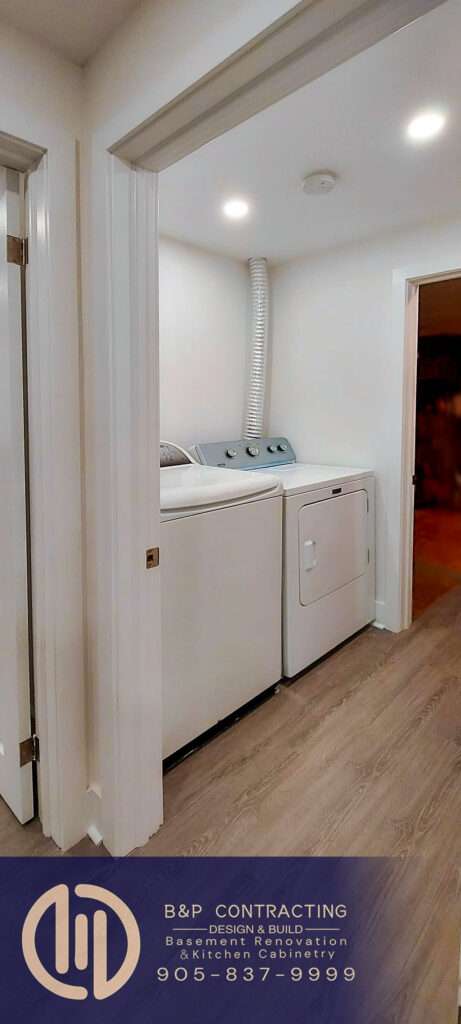Pros and Cons of Having a Basement Laundry Room

Laundry rooms are an essential part of any home, providing a dedicated space for washing, drying, and folding clothes. While many homes have their laundry rooms on the main floor or even in the upper levels, some homeowners opt to have their laundry rooms in the basement. Like any design choice, there are both advantages and disadvantages to having a basement laundry room. In this article, we’ll explore the pros and cons of this particular setup.
Pros:
Space Utilization : Basements often offer ample space, making them ideal for laundry rooms. With more room to spare, homeowners can install larger appliances, storage shelves, and even create a folding area without compromising space in other parts of the house.
Noise Reduction: Laundry machines can be a nuisance, causing a disturbance amongst occupants. Placing the laundry room in the basement can help minimize noise, particularly if the basement is well-insulated. This can be beneficial, especially in households where bedrooms or living spaces are located adjacent to or above the laundry area.
Temperature Control : Basements typically maintain a more consistent temperature throughout the year compared to other parts of the house. In hot climates, this can prevent laundry rooms from becoming uncomfortably warm, while in colder climates, it can prevent freezing during winter months.
Additional Utility Sink –Basements often offer the flexibility to include additional amenities such as utility sinks. Having a sink in the laundry room can be incredibly convenient for tasks like hand-washing delicate garments, cleaning muddy shoes, or filling buckets for household chores.
Extra Storage : Basement laundry rooms often come with extra storage space. Homeowners can utilize this space to store laundry detergents, cleaning supplies, seasonal clothing, and other household items without cluttering up main living areas.
Privacy : For larger households, having the laundry room tucked away in the basement can provide a sense of privacy. It allows family members to do laundry without disrupting activities in the main living areas, making it easier to maintain a sense of order and cleanliness in the home.
Cons:
Accessibility : One of the primary drawbacks of basement laundry rooms is accessibility. Constantly going up and down stairs with heavy laundry baskets can be inconvenient, especially for elderly individuals or those with mobility issues. This setup may also be challenging for families with young children who require supervision near stairs.
Moisture and Humidity : Basements are prone to higher levels of moisture and humidity compared to other parts of the house. This environment can promote mold and mildew growth, potentially causing damage to both the laundry room and the items stored within it. Proper ventilation and dehumidification are essential to mitigate these issues.
Limited Natural Light : Most basements have limited access to natural light, which can make the laundry room feel dark and dingy. Without adequate lighting, it may be challenging to spot stains, sort clothes, or perform other tasks effectively. Installing artificial lighting or utilizing reflective surfaces can help brighten up the space.
Potential for Flooding : Basements are susceptible to flooding, whether from heavy rains, plumbing leaks, or appliance malfunctions. A flooded basement can cause significant damage to laundry equipment, flooring, walls, and stored items. Installing a sump pump and taking preventative measures can reduce the risk of flooding.
Ventilation Challenges : Proper ventilation is crucial in laundry rooms to expel moisture, odors, and airborne particles generated during the laundry process. However, achieving adequate ventilation in a basement can be more challenging than in above-ground rooms. Installing exhaust fans or vents may require additional modifications to the basement structure.
Potential for Pest Infestation : Basements are often more susceptible to pests such as rodents and insects. These pests can find their way into the laundry room, potentially contaminating clothes and causing hygiene concerns. Regular pest control measures and sealing any entry points can help mitigate this risk.
In conclusion, while basement laundry rooms offer several advantages such as ample space, noise reduction, and temperature control, they also come with their own set of challenges including accessibility issues, moisture concerns, and limited natural light. Homeowners considering a basement laundry room should carefully weigh these pros and cons to determine if this setup aligns with their needs and preferences. Additionally, implementing proper maintenance and precautionary measures can help address many of the drawbacks associated with basement laundry rooms, ensuring a functional and comfortable space for laundry tasks.
